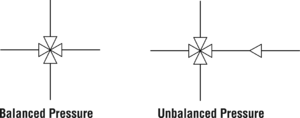Difference between revisions of "Normal hydrostatic pressure"
(Initial import) |
Cwhitehurst (talk | contribs) |
||
| Line 36: | Line 36: | ||
==Static vs. dynamic fluids== | ==Static vs. dynamic fluids== | ||
| − | |||
| − | [[file:formation-fluid-pressure-and-its-application_fig5-1.png|thumb|{{figure number| | + | [[file:formation-fluid-pressure-and-its-application_fig5-1.png|thumb|{{figure number|1}}See text for explanation.]] |
| + | |||
| + | Fluid pressure is nondirectional if the fluid is static. If a pressure imbalance exists in any direction, the fluid moves in the direction of lower fluid pressure. The diagrams in [[:file:formation-fluid-pressure-and-its-application_fig5-1.png|Figure 1]] illustrate balanced and unbalanced pressures. | ||
==See also== | ==See also== | ||
Revision as of 19:52, 13 February 2014
| Exploring for Oil and Gas Traps | |

| |
| Series | Treatise in Petroleum Geology |
|---|---|
| Part | Critical elements of the petroleum system |
| Chapter | Formation fluid pressure and its application |
| Author | Edward A. Beaumont, Forrest Fiedler |
| Link | Web page |
| Store | AAPG Store |
Fluids[edit]
A fluid is “a substance (as a liquid or gas) tending to flow or conform to the outline of its container” (Webster, 1991). Thus, the explorationist should think of oil, gas, and water as fluids to understand their behavior in the subsurface. In this chapter, where the fluid state (liquid or gaseous) is important, the state (or phase) is specified.
Fluid pressure[edit]
Fluid pressure is that pressure exerted at a given point in a body of fluid.
Hydrostatic pressure[edit]
Normal hydrostatic pressure is the sum of the accumulated weight of a column of water that rises uninterrupted directly to the surface of the earth. Normally pressured fluids have a great degree of continuity in the subsurface through interconnected pore systems. Abnormally pressured fluids can occur where fluids are completely isolated in containers (compartments) that are sealed on all sides.
Hydrostatic mud pressure[edit]
The geological definition of “hydrostatic” differs from the engineering definition. Engineers use “hydrostatic” to refer to the pressure exerted by the mud column in a borehole at a given depth. Hydrostatic mud pressures are found on DST (drill-stem test) reports and on scout ticket reports of DSTs.
Properties of hydrostatic pressure[edit]
Normal hydrostatic pressure has the following properties:[1]
- Amount of pressure increases with depth.
- Rate of pressure change depends only on water density.
- Vector representing the direction of maximum rate of pressure increase is vertical (i.e., the fluid is not flowing laterally).
- The pressure-depth relationship is completely independent of the shape of the fluid container.
Static vs. dynamic fluids[edit]
Fluid pressure is nondirectional if the fluid is static. If a pressure imbalance exists in any direction, the fluid moves in the direction of lower fluid pressure. The diagrams in Figure 1 illustrate balanced and unbalanced pressures.
See also[edit]
- Pressure regimes
- Geostatic and lithostatic pressure
- Normal hydrostatic pressure gradients
- Abnormal hydrostatic pressure
- Causes of overpressure
- Causes of underpressure
References[edit]
- ↑ Dahlberg, E., C., 1994, Applied Hydrodynamics in Petroleum Exploration, 2nd ed.: New York, Springer-Verlag, 295 p. Excellent subsurface fluid pressure reference. Covers hydrodynamic and static fluids.
